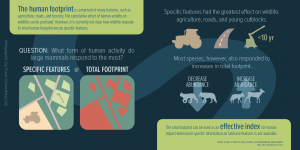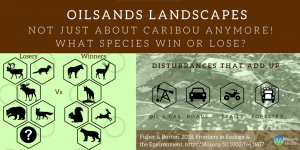Two new papers have recently been published by Cole and colleagues that highlight the varied effects of anthropogenic disturbances on larger mammals in Alberta’s boreal forests.
Mary Toews published one of her M.Sc. thesis chapters in the Journal of Environmental Management (Toews, M. F. Juanes and A.C. Burton. 2018. Mammal responses to the human footprint vary across species and stressors. J Environ Manage 217:690-699) . This work used a large dataset of snowtrack surveys from the Alberta Biodiversity Monitoring Institute and highlighted that species respond differently to different types of land use, and differently from each other, but that the total amount of disturbance (“footprint”) could be used as a coarse index of overall impact.
And Cole collaborated with Jason Fisher (UVic and Innotech Alberta) on a paper published in Frontiers in Ecology and the Environment (Fisher, J.T and A.C. Burton. 2018. Wildlife winners and losers in an oil sands landscape. In press at Frontiers in Ecology and the Environment). This research used 3 years of camera trap data from one part of Alberta’s oil sands region to show that anthropogenic disturbances have at least as much effect on mammal distributions as natural habitat features, with some species positively associated with disturbance and others negatively.
There is much more work to be done to reliably assess cumulative environmental impacts on mammals and other wildlife at appropriate spatial and temporal scales, and to inform evidence-based wildlife management. We’re looking forward to continuing this work at WildCo!

